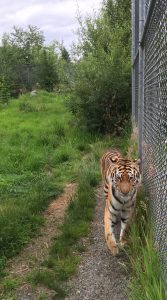An outdoor classroom is a truly powerful space and I doubt anyone would argue the merits of taking your students and putting them in a new environment, one that is in stark contrast to the walls and desk they usually inhabit. In this outdoor space, the students are given the chance to self-explore the space, forming their own questions, answering those inquiries, and developing a lens of critical thinking. For the development of these skills, I doubt there a location that is truly more perfect than the zoo.
So now that I am here at the zoo, surrounded by lions and tigers and bears (oh my), what am I doing here to further my personal development as a teacher? The educational programming here at the Greater Vancouver Zoo is truly wonderful and provides teachers with some strong tools to help their students make the most of their trip. The programming has many different levels and areas of focus. Kindergarten-Grade 1 “Introduction to the Zoo” tours, “Amazing Animal Adaptations” for upper primary students, even “Animal Mythology” programs for intermediate and middle school students. All of these programs are well designed and contain a wealth of resources to accompany the already incredibly resource of the zoo itself. However, along exploration of these programs, while thumbing through the resources, I noticed something was missing. Something that I as a educator would be thrilled to have before I brought my class to the zoo. Curricular Connections. Something that has been wonderful this year is our opportunity to discuss, experiment with, and implement the transformed BC curriculum. In my practicum, this was a valuable portion of my UBC coursework as I had a great deal of experience with the “new” curriculum. In that scenario, I could pass on my knowledge to those around me and now I found myself in a similar situation. What a wonderful thing it would be to have the curricular and content connections from the curriculum to go along with your pre-package of your upcoming zoo program. Adaptation program? Well here are the Grade 2 and 3 skills and content, along with the a key “Big Idea”. Along with this, here are a few extension projects to consider for an inquiry-style unit. In fact, as it is so heavily focused on in the curriculum, here is the skeleton of a unit based on inquiry, using the field trip as exploration time for the students to inquire, question, re-think, and draw conclusions about the ideas the teacher had pre-taught. This would be a powerful resource to be given as an educator in preparation for an upcoming trip to accompany the already powerful resources of the animals themselves.
So here I am. Unit planning, developing resources, and putting in place scaffolding that will allow students to make real life connections before, during, and after their visit to the zoo. To put it plainly, I’m doing exactly what I’ve been trained to do and what I’ve been doing for the past 9 months…only this time with tigers.

Hana (the most beautiful thing ever)